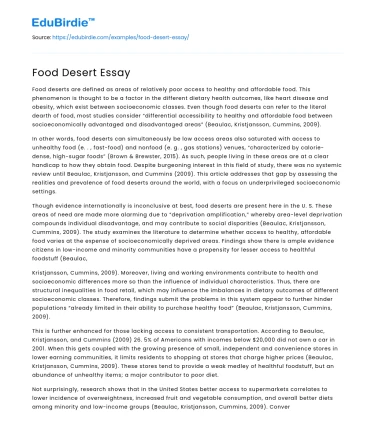Food deserts are defined as areas of relatively poor access to healthy and affordable food. This phenomenon is thought to be a factor in the different dietary health outcomes, like heart disease and obesity, which exist between socioeconomic classes. Even though food deserts can refer to the literal dearth of food, most studies consider “differential accessibility to healthy and affordable food between socioeconomically advantaged and disadvantaged areas” (Beaulac, Kristjansson, Cummins, 2009).
In other words, food deserts can simultaneously be low access areas also saturated with access to unhealthy food (e. . , fast-food) and nonfood (e. g. , gas stations) venues, “characterized by calorie-dense, high-sugar foods” (Brown & Brewster, 2015). As such, people living in these areas are at a clear handicap to how they obtain food. Despite burgeoning interest in this field of study, there was no systemic review until Beaulac, Kristjansson, and Cummins (2009). This article addresses that gap by assessing the realities and prevalence of food deserts around the world, with a focus on underprivileged socioeconomic settings.
Save your time!
We can take care of your essay
- Proper editing and formatting
- Free revision, title page, and bibliography
- Flexible prices and money-back guarantee
Though evidence internationally is inconclusive at best, food deserts are present here in the U. S. These areas of need are made more alarming due to “deprivation amplification,” whereby area-level deprivation compounds individual disadvantage, and may contribute to social disparities (Beaulac, Kristjansson, Cummins, 2009). The study examines the literature to determine whether access to healthy, affordable food varies at the expense of socioeconomically deprived areas. Findings show there is ample evidence citizens in low-income and minority communities have a propensity for lesser access to healthful foodstuff (Beaulac,
Kristjansson, Cummins, 2009). Moreover, living and working environments contribute to health and socioeconomic differences more so than the influence of individual characteristics. Thus, there are structural inequalities in food retail, which may influence the imbalances in dietary outcomes of different socioeconomic classes. Therefore, findings submit the problems in this system appear to further hinder populations “already limited in their ability to purchase healthy food” (Beaulac, Kristjansson, Cummins, 2009).
This is further enhanced for those lacking access to consistent transportation. According to Beaulac, Kristjansson, and Cummins (2009) 26. 5% of Americans with incomes below $20,000 did not own a car in 2001. When this gets coupled with the growing presence of small, independent and convenience stores in lower earning communities, it limits residents to shopping at stores that charge higher prices (Beaulac, Kristjansson, Cummins, 2009). These stores tend to provide a weak medley of healthful foodstuff, but an abundance of unhealthy items; a major contributor to poor diet.
Not surprisingly, research shows that in the United States better access to supermarkets correlates to lower incidence of overweightness, increased fruit and vegetable consumption, and overall better diets among minority and low-income groups (Beaulac, Kristjansson, Cummins, 2009). Conversely, augmented access to convenience stores is associated with higher risk of obesity. This deprivation amplification cycle makes it incredibly difficult for lower income populations to rise up and transform their dietary habits for the better.
Quite simply, healthy food leads to better diet. What is more, the perception of better and fresher produce may contribute to increased fruit and vegetable consumption (Beaulac, Kristjansson, Cummins, 2009). Compounding the problem further, studies show higher prices are found in small stores and nonfood venues, a greater occurrence of which are found in low-income and minority locales. Additionally, higher prices for healthier food baskets is backed by recent economic nalysis demonstrating “energy-dense diets cost less than healthier diets” (Beaulac, Kristjansson, Cummins, 2009). This suggests people with limited financial means for food may not be able to purchase healthful foods. In fact, low income populations cite high costs of healthy food items as a barrier to healthful eating habits (Beaulac, Kristjansson, Cummins, 2009). Studies have shown lower prices on fruits and vegetables are associated with lower body mass index, which may help show how pricing plays a strong role in producing the phenomenon of food deserts.
Roughly 23. 5 million people reside in urban neighborhoods and rural towns with limits to accessing fresh, affordable, and healthy foodstuff (Gupta, 2015). Hence, residents are often forced to depend on fast food and convenience stores with inadequate supplies of fresh produce. Gupta (2015) states people in these settings “struggle more with obesity and chronic conditions, and have shorter life expectancies than people who live in neighborhoods with easy access to healthy food.
Although some local organizations and markets are lending support to help eradicate food deserts, it is not enough. The most abundant food supply in the world means little if people cannot get what they need to be healthy. Looking at Seattle, neighborhoods facing this problem are laid all around the city center. From First Hill and South Park to communities on the Duwamash River, the city must work to find solutions to the food desert puzzle here at home.






 Stuck on your essay?
Stuck on your essay?

